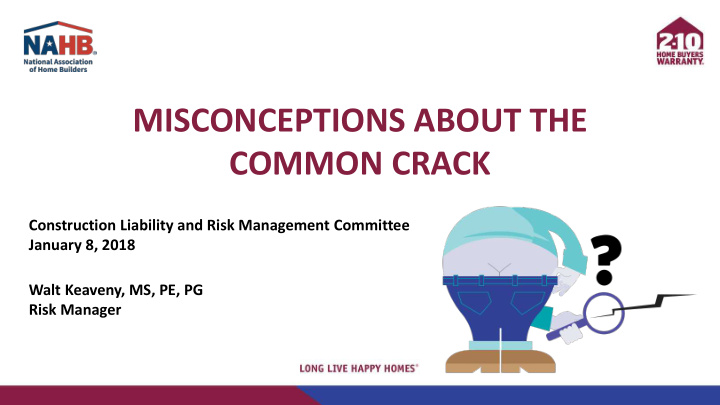



MISCONCEPTIONS ABOUT THE COMMON CRACK Construction Liability and Risk Management Committee January 8, 2018 Walt Keaveny, MS, PE, PG Risk Manager
CRACK FACTS If there is one thing a Home Builder can guarantee for every new home…cosmetic cracks will develop Cracks are the No. 1 homeowner concern when calling warranty administration with structural questions The vast majority of cracks are “cosmetic,” not “structural” There is no absolute universal standard for evaluating cracks
AGENDA What causes common “cosmetic” cracks Examples of Crack Construction Performance Standards How to identify a potential “structural” crack Structural crack action items Qualifying Structural Defect
“FOUNDATION MOVEMENT” CAUSES COMMON COSMETIC CRACKS All foundations on soil will move Soils adjust to the load of the foundation, and to soil moisture changes Conventional spread footing foundations are designed to move up to 1.0” Slab-on-grade foundations can be designed to move up to 4.5”
“LOSS OF MOISTURE” CAUSES COMMON COSMETIC CRACKS Materials that dry and crack include Concrete, Grout, Mortar, Plaster, and Stucco Loss of moisture causes shrinkage cracks. The more the initial moisture, the greater the potential for cracks. Moisture variations in Framing Lumber (Rules of Thumb) • Kiln dried is 12-15% moisture content; Equilibrium in home is 10-12% • Wood can absorb moisture to 28-30% • 4% moisture change causes 1% size change
“TEMPERATURE VARIATIONS” CAUSE COMMON COSMETIC CRACKS The most extreme movements are in areas with the highest daily or seasonal temperature changes, like exterior walls and attics Coefficient of Linear Thermal Expansion 5.5 (10 -6 ) in./in./F° Concrete 2.8 (10 -6 ) in./in./F° Drywall and Wood Outside air temp. = 50-95°F, concrete in sun = 125° (red brick = 135°) 100-ft outside concrete wall with 75°F change expands/contracts 0.50” 100-ft inside drywall wall with 15°F change expands/contracts 0.05”
OTHER CAUSES OF COMMOM COSMETIC CRACKS Wind Loads Normal joist, beam, truss, and lintel deflection Earthquake
CONSTRUCTION JOINTS (prevent cracking, or allow for aesthetically pleasing cracking) Control Joint – Joint widens as concrete shrinks Expansion Joint – Joint narrows as brick expands Slip Joint – Allows independent movement of structural components
Establish workmanship crack PERFORMANCE STANDARDS, or else default to “GOOD AND WORKMANLIKE” Third-Party Warranty Construction Performance Standards NAHB’s “Residential Construction Performance Guidelines” Concrete Footing > 1/4” Concrete Floor Slab > 3/16” Concrete Basement Wall > 1/4” Engineering Standards (example by R.W. Day 2011) Cement Board Siding > 1/8” Negligible to Slight – Hairline to 1/8” Masonry Wall or Mortar Joint > 1/4” Moderate – 3/16” to 9/16” Stucco > 1/8” Severe – 9/16” to 1” Tile Grout 1/16” Very Severe -- > 1” Drywall > 1/16”
INDICATIONS OF POTENTIAL STRUCTURAL CRACKS Large cracks and separations 1) Excessive floor deflection or tilt 2) Inoperable doors and windows 3) Excessive wall and surface slopes, bowing, or leaning 4) Cracks with vertical displacement 5) Horizontal basement wall cracks, especially with 6) bowing or leaning
IF STRUCTURAL CRACKS ARE SUSPECTED Call the experts at your warranty company 1. Seek consultation from a qualified professional Engineer 2. Engineer will measure and photograph cracks 3. A floor elevation survey may be conducted to assess deflection and tilt 4. All collected data can be used as a reference for monitoring movement 5.
QUALIFYING 10-YEAR STRUCTURAL DEFECT – EXAMPLE DEFINITIONS HUD 24 CFR 203.200 -- “Actual physical damage to the designated load bearing elements of the home caused by failure of such load bearing elements which affects their load bearing functions to the extent that the home becomes unsafe, unsanitary, or otherwise unlivable .” New Jersey Dept. of Community Affairs -- “A Major Structural Defect means any actual damage to the load-bearing portion of the Home, including consequential damages, due to subsidence, expansion or lateral movement of the soil (excluding movement caused by flood or earthquake) that affects its load-bearing functions and that vitally affects or is imminently likely to vitally affect use of the Home for residential purposes .” Texas Assoc. of Builders -- “(A) Overall deflection from the Original Construction Elevations shall be no greater than the overall length over which the deflection occurs divided by 360 (L/360) and must not have more than one associated symptom of distress, as described in Section 5 of the ASCE Guidelines, that result in actual observable physical damage to the home. L shall be defined as the edge to edge distance across any slab cross-section for which overall deflection is calculated. (B) The slab shall not tilt after construction in excess of one percent across any overall dimension of the home or cause structural component(s) or masonry veneer to rotate into a structurally unstable position such that the weight of the component part falls outside the middle third of its bearing area.”
Best Practices 1. Avoid construction practices that cause cracks 2. Plan for cracks with construction joints 3. Establish contractual crack performance standards 4. Manage homeowner expectations 5. Retain an expert for structural cracks, and to determine if a qualifying structural defect
Thank You
Recommend
More recommend